#tsutsugaki
Text

Japanese hikeshibanten jacket depicting spider and go board, 19th Century, Seattle Art Museum
2K notes
·
View notes
Text

Shoichi Tsurukawa — Nature Along with Forest Lives (paste, sirius dyes, cotton on panel, 2019)
709 notes
·
View notes
Text

一件 19 世紀的日本消防員外套,上面裝飾著一隻盤旋在廢棄圍棋棋盤上的蜘蛛。
A 19th century Japanese Firemen’s coat decorated with a spider hovering over an abandoned Go board.
-from "Museum Of Artifacts"history blog-
an early-nineteenth-century firefighter’s coat, called hikeshibanten, since it features a spooky spider. Made in the Edo period in Japan, these firefighter’s coats were reversible, and this design is actually on the interior of the jacket, only visible when the jacket has been turned inside out. A large spider—with an endearing face—looms over the shoulder of the jacket, where it hovers menacingly over an abandoned go board (Pacific Northwesterners may have unnerving flashbacks to the giant house spiders that descend on Seattle in the autumn). The range of tonalities centers on indigo, white, black, and greyish-brown, with red accents on the fan; this color palette visually unites the work, creating parallels between the spider’s eyes and the go pieces.
The method of dyeing used, tsutsugaki, is a type of resist dyeing. The design was drawn on the cotton using rice paste, and these initial lines are visible now as the lightest areas of the design. The spider and the go board were dyed their respective colors, and covered with more rice paste to block any other dye from entering the area. Then the fabric was dipped into indigo multiple times, dried, soaked in hot water again, and the rice paste was scraped off to reveal the layering of colors; this whole process could take 20 days.
The scene is from the story of the warrior-hero Minamoto no Yorimitsu (948–1021) who, once when sick, was visited by an evil priest in the guise of a giant spider. Yorimitsu saw through the disguise and attacked the spider priest, and his four attendants (who were playing a game of Go while guarding him) leapt up to track the intruder back to his den.
5 notes
·
View notes
Video
Okinawa, Japan, Wrapping cloth with floral design, 19th century, ramie, tsutsugaki, 9/4/22 #artsmia #textiles by Sharon Mollerus
#Minneapolis Institute of Art#19th century#museum#Minnesota#artsmia#ramie#Japan#tsutsugaki#Wrapping cloth with floral design#textiles#Okinawa#Minneapolis#MN#flickr
0 notes
Photo

Fireman's jacket (hikeshi-banten) with Shogun Tarō Yoshikado. Edo period (1615–1868), mid-19th century. Quilted cotton with tube-drawn paste-resist dyeing (tsutsugaki) with hand-painted details. 36 x 49 in. ( 91.4 x 124.5 cm). John C. Weber Collection. MET
149 notes
·
View notes
Text
Another fave from The Met's #KimonoStyle show for #FrockFriday + bonus #FroggyFriday:

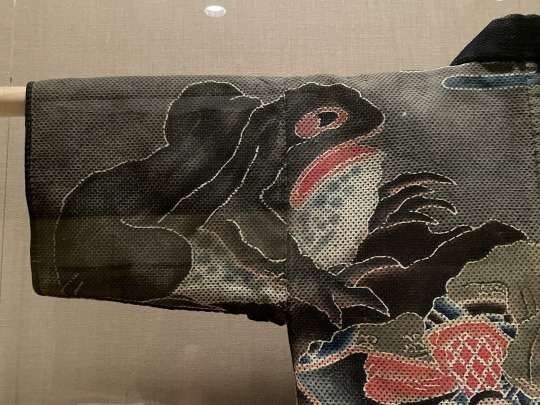

Fireman's Jacket (Hikeshi-banten) w/ Shogun Taro Yoshikado
Japan, Edo period (1615-1868), mid-19th century
Quilted cotton with tube-drawn paste-resist dyeing (tsutsugaki) with hand-painted details
John C. Weber Collection
“[The jacket] features a scene popular in Kabuki & based on a print by Utagawa Kunisada (1786-1865) in which the warrior Yoshikado asks a frog sage for magical powers to avenge the murder of his father.” This is that print:

Utagawa Kunisada (Japanese, 1786-1865)
"Actor Nakamura Shikan IV as Shōgun Tarō Yoshikado"
1862, 12th lunar month
Publisher: Hiranoya Shinzō
Dimensions: 14 9/16 × 9 3/4 in. (36.99 × 24.77 cm) (image, vertical ōban)
Print (ukiyo-e / yakusha-e); Woodblock print (nishiki-e); ink and color on paper
Portfolio: From Toyokuni's Drawings: A Magic Contest (Toyokuni kigō: Kijutsu kurabe 豊国揮毫 奇術競)
Minneapolis Institute of Art 2016.137.2
BTW that “frog sage” is Gama Sennin, the Toad Immortal; here is another woodblock print (actually a triptych) by the same artist of the same legend:
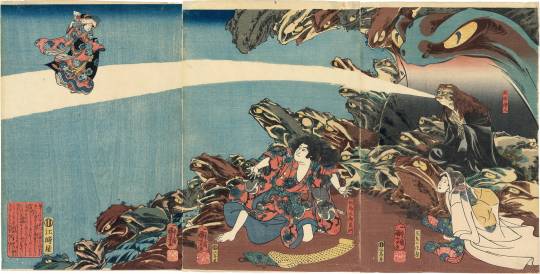
Utagawa Kunisada (Japanese, 1786-1865)
“Gama Sennin Instructing Yoshikado and Takiyasha," 1845
ôban triptych (38 x 77.5 cm)
“Gama Sennin is the toad immortal, and here they appear almost like an old woman, with their long hair fashioned from a toad-faced pelt and appearing in a toad-like body. Here the magician demonstrates their magic, causing the image of a young woman to materialize on their breath. Gama Sennin, the Toad Immortal, is based upon the Chinese Immortal Liu Hai, the Sage with the Toad on his back, a benign sage with great magical powers. Kuniyoshi has outdone himself with the cave of Gama Sennin, as all the rocklike outcroppings are comprised of frogs, and a giant frog spectre hovers over the magician. In the center panel, Yoshikado has been consulting a scroll of some sort, and looks up in surprise, his hands in the ‘astonished’ gesture that Kuniyoshi favored. The motivation of the two young people is of course vengeance for a murdered loved one. A scarce design.”
image & info via https://egenolfgallery.com/products/kuniyoshi-gama-sennin-and-frog-magic
#frog#toad#amphibians#Japanese art#East Asian art#19th century art#historical costume#textiles#garment#Hikeshi-banten#Utagawa Kunisada#Taro Yoshikado#Kabuki#Gama Sennin#frog sage#toad sage#Toad Immortal#Japanese mythology#Japanese folklore#John C Weber Collection#Metropolitan Museum of Art New York#Kimono Style#exhibition#museum visit#Frock Friday#Froggy Friday#animals in art
40 notes
·
View notes
Photo

Indigo dyed cotton tsutsugaki yogi, a sleeping kimono - mid-to-late nineteenth century.
33 notes
·
View notes
Text



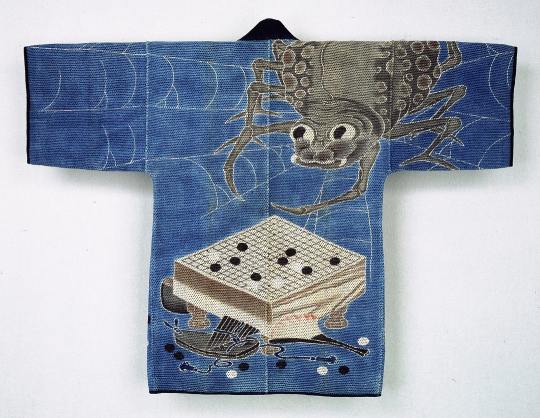


19th century Japanese Firemen’s Coats
Each firefighter in a given brigade was outfitted with a special reversible coat (hikeshi banten), plain but for the name of the brigade on one side and decorated with richly symbolic imagery on the other. Made of several layers of quilted cotton fabric, using a process called the sashiko technique, and resist-dyed using the tsutsugaki method, these coats would be worn plain-side out and thoroughly soaked in water before the firefighters entered the scene of the blaze.
1. The wizard Jiraiya turning into a giant toad
2. A scene famous from prints and Kabuki plays - the samurai Sato Tadanobu, ambushed by enemies while playing the game Go, is unable to reach his weapons so defends himself with the game's heavy wooden table, scattering the black and white stone game pieces
3. Interlocking circles, Chinese characters (Kanji) and ginkgo leaves
4. A spider hovering over an abandoned Go board
5. A tiger and dragon motif
6. A dragon motif
0 notes
Text

Tsutsugaki
"méthode de teinture en réserve à main levée, où la pâte de riz additionnée de chaux est utilisée pour dessiner le contour des motifs sur le tissu en le pressant à travers un tube étroit de forme conique. Les motifs pouvaient pouvaient alors être réalisés à la main avec des teintures polychromes, puis recouverts de davantage de pâte et immergés ensuite pour obtenir la teinture du fond. Une fois celle-ci effectuée, la pâte était lavée pour révéler des motifs audacieux et dynamiques. Le Tsutsugaki était souvent utilisé pour les textiles où la visibilité des motifs était essentielle, comme les bannières, les tissus d'emballages et les cstumes de scène."
0 notes
Text

Shoichi Tsurukawa — Colored Tree Buds III (cotton art cross, paste, sirius dyes, cotton on panel, 2017)
339 notes
·
View notes
Photo
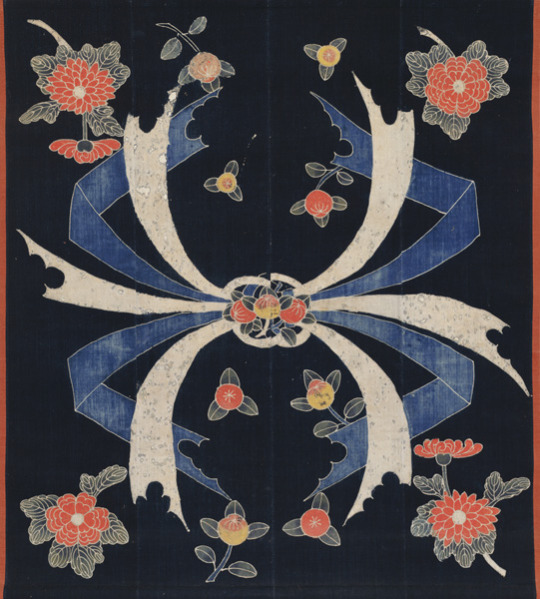
熨斗菊橘文様夜具地〈のしきくたちばなもんようやぐじ〉
木綿、筒描 軸装 江戸~明治時代〔日本〕 19世紀
354 notes
·
View notes
Text
Japan Journal pt4: Izumo tsutsugaki workshop production visit
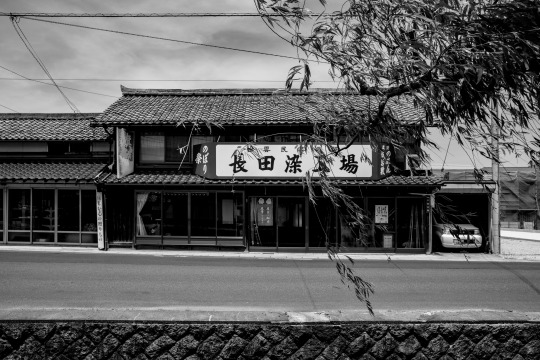

I have been collaborating with LINK textiles for a number of years creating artwork for furoshiki - a traditional Japanese textile format- a multi-functional square piece of cloth, historically used to wrap clothes to transport to the bathhouses, and in more recent times to wrap gifts with. Each design I have made explored the portability of the function, the nomadic qualities of these transportable cloths, as subjective maps.
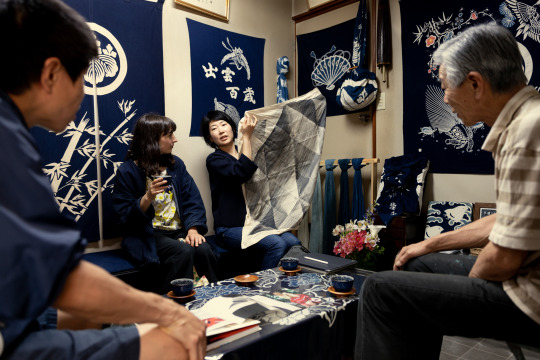
Recently I was invited by LINK to create artwork for another traditional Japanese textile process - tsutsugaki - literally meaning ‘tube drawing’, which uses a rice paste to act as a resist in combination with natural indigo dyeing, to create textile artworks, historically produced as wedding gifts in the form of bedspreads, and wall hangings, and also as ‘noren’, curtains that act as inviting entranceways to spaces. Having witnessed some beautiful examples of tsutsugaki noren on my last trip to Japan in 2012, and always keen to embrace the limitations and therefore potential of a new process, I was delighted to accept this commission. As luck should have it, I was able to join Kyoko of LINK on a production visit of the tsutsugaki workshop in Izumo, this May, as part of my QEST research trip.

Landing in Tokyo, I skirted around the city, from Narita to Hakeda airport to join LINK creator Kyoko and long-term photographer of all things LINK Martin Holtkamp to fly to the far west of the main island of Honshu, to the small coastal city of Izumo. Getting on the small bus that took us on the short hop from the airport to the centre, glimpsing fragments of the landscape as the sun set, we settled into the quiet confidence of the place, pulsing along to its own quiet rhythm, which I discovered is steeped in spiritual history, craft and its own distinct culture. After the most delicious seafood feast in a quiet backstreet of Izumo, and a midnight dip in the hotel’s own onsen, I felt perfectly at home.

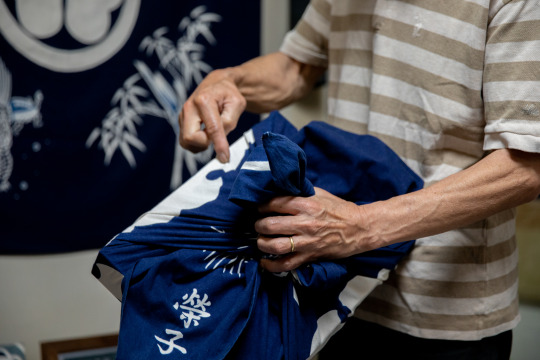
The next morning, we arrived at the workshop to be greeted by Mr Nagata and his son, and their dog Beck in a cosy corner of their workshop, the entirety of the space adorned with their craftsmanship - wall hangings, furoshiki, banners, table cloths and more. Over Japanese tea for the next hour Kyoko and the father-son duo discussed in Japanese the intricacies of the technique, the current state of the industry of Japanese craft textiles, the tools, their customers, as well as the rich culture of Izumo. We were shown work from his ancestors from the Meiji period, a baby blanket of exquisite detail, fortuitous cranes and turtles under a sunset cloud, and a bed spread of family crests, sewn together from 4 pieces, still luminously rich with indigo, despite the passing centuries.

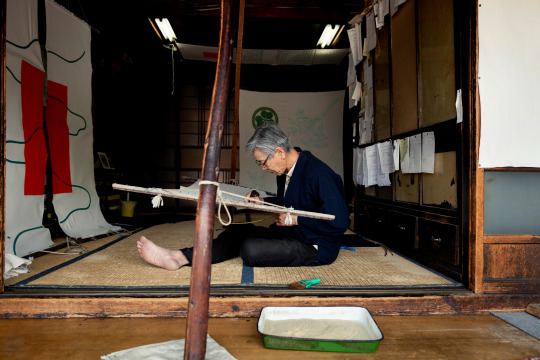
We were then guided through the process through a series of demonstrations. I spotted my artwork draped in mid air above our heads, and another half of the noren was retrieved and suspended it the upper part of their studio in order for Mr Nagata senior to demonstrate the application of the design, the ‘tubedrawing’. He filled his tube tool with the paste, and began to ‘paint’ on my design, that had already been marked out in pencil, sucking on the tube every few minutes to release air bubbles, and he sat with repose on the tatami mat, in the morning light, attentively applying the resist paste to the cloth. After completing a section, he would throw on some rice husks and dust them across the work, to help seal in the paste to the fabric.



The dyeing room was his son’s domain and we watched with delight seeing the magical transformative process of indigo dyeing take place on our noren pieces. The dyeing room with the 6 vats sunken into the ground had the patina of countless years of dyeing and we couldn't help but watch with wonder as we witnessed the metamorphosis from white to green to blue, as the oxidation takes place. Above the dye vats in the corner of the ceiling we noticed a shinto shrine to the goddess of indigo dyeing, commonly told to be filled with jealousy should any female do any dyeing, so indigo dyeing is strictly a male business.

Seeing our designs be submerged in the the vats, and remerge transformed into colour so rich, for fabric to be so utterly transformed by the power of nature was a bewildering thing to watch, and what struck me was how gentle this process seemed. Rice paste, rice husks, paper tubes with a metal tip, indigo vats with only fermented natural indigo and nothing else added. Then the large fabric swathes are taken out to the canal just outside the workshop, tied to a pole in the middle of the gushing river, and the rivers flow washes the natural indigo away with a little help from Mr Nagata to beat away the remaining rice paste. It takes at least 10 dips, each having to dry for hours in-between dips, then carefully washed, dried, ironed, then sewn by Mrs Nagata on site.

After warm good-byes, bows and the trading of business cards, we were kindly driven to the local Shussai pottery, and adjoining cafe where we tucked into the most delicious curry before heading back east on the Shinkansen bullet train to Kyoto. We left filled with the joy of experiencing dedicated craftsmanship, one of only 2 remaining tsutsugaki factories remaining in Japan, and a feeling of gratitude of experiencing artistic collaboration across the world.

All photos courtesy of Martin Holtkamp / LINK
Visit https://linkcollective.com for more info on our latest tsutsugaki collaboration.
2 notes
·
View notes
Photo

Stripe on stripe #modesty_industry #modestyindustry #modesty #shibori #tiedye #senshoku #handdyed #dyed #indigodye #indigo #藍染 #絞り染め #タイダイ染め #染色 #tsutsugaki #筒描き #三軒茶屋 #sallysjourney #hotdog #🌭 #izu #伊豆 (Sally's Journey) https://www.instagram.com/p/CgltQE1vuLW/?igshid=NGJjMDIxMWI=
#modesty_industry#modestyindustry#modesty#shibori#tiedye#senshoku#handdyed#dyed#indigodye#indigo#藍染#絞り染め#タイダイ染め#染色#tsutsugaki#筒描き#三軒茶屋#sallysjourney#hotdog#🌭#izu#伊豆
0 notes
Text
Tsutsugaki
Jim Austin at Kimonoboy.com has written a great blog post on this traditional cone-applied resist technique that I wanted to share.


“ Japanese tsutsugaki folk textiles are renowned for their bold, traditional, auspicious and life-affirming pictorial motifs. Throughout rural Japan, tsutsugaki pieces were made by commoners for use by their fellow commoners. Rural folk commissioned tsutsugaki craftsmen to create depictions of dramatic and propitious motifs on indigo resist-paste dyed cotton or hemp cloth as a way of conveying unspoken meaning and significance to important life, religious and cultural celebrations...” click here to read more.
Jim is so knowledgeable about Japanese Folk Textiles and his shop is one of the few (and best) places to locate these exceptional collector pieces. He also offers a free e-book download on Japanese Boro Farmer’s Garments that I also highly recommend for anyone interested in indigo, boro, or traditional baste or cotton fiber garments.
#tsutsugaki#kimonoboy#indigo#japanesetextile#antiquejapanesekimono#rice paste resist#indigo dying#traditional japanese textile#japanese farmer textile#jim austin
2 notes
·
View notes
Text




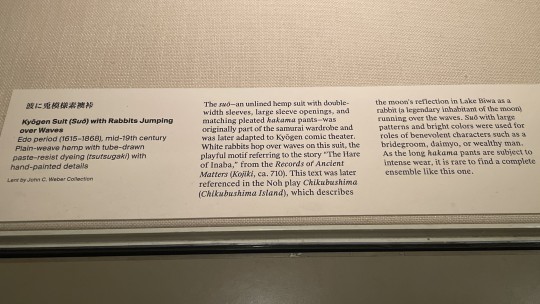
#LunarNewYear #YearOfTheRabbit at the Metropolitan Museum of Art, New York:
Kyōgen Suit (Suō) with Rabbits Jumping over Waves
Japan, Edo period
mid-19th century
plain-weave hemp with tube-drawn paste-resist dyeing (tsutsugaki) with hand-painted details
dimensions: Jacket (a): 31 1/8 × 71 in. (79.1 × 180.3 cm)
"The suō—an unlined hemp suit with double-width sleeves, large sleeve openings, and matching pleated hakama pants—was originally part of the samurai wardrobe and was later adapted to Kyōgen comic theater. White rabbits hop over waves on this suit, the playful motif referring to the story “The Hare of Inaba,” from the Records of Ancient Matters (Kojiki, ca. 710). This text was later referenced in the Noh play Chikubushima (Chikubushima Island), which describes the moon’s reflection in Lake Biwa as a rabbit (a legendary inhabitant of the moon) running over the waves. Suō with large patterns and bright colors were used for roles of benevolent characters such as a bridegroom, daimyo, or wealthy man. As the long hakama pants are subject to intense wear, it is rare to find a complete ensemble like this one."
Photographed on display at the Met's Kimono Style exhibition (catalog entry here).
#rabbit#rabbits#mammals#kimono#suō#Kyōgen#Kojiki#The Hare of Inaba#Chikubushima#textiles#historical costume#theatre#Japan#Japanese art#Asian art#19th century#Metropolitan Museum of Art New York#Kimono Style#exhibition#museum visit#animals in art
16 notes
·
View notes
Photo

Sashiko x Tsutsugaki Hand-dye Vintage Fabric. Because of my “boxed-idea of Sashiko”, Keiko’s colorful Sashiko always impress me. This collaboration could be something only we (who live in today) can do. The Tsutsugaki fabric was, “probably”, too expensive for someone who practiced Sashiko stitching. ☆ Katazome, Tusugaki, many types of Hand-Dye culture is also the Japanese cultural form that has risks to be lost. It is simply too “troublesome” to keep practicing it. Therefore, we would like to appreciate each craftsmanship and respect the process. “Beautiful” is a great compiment we can get. At the same time, I want you to feel more than “beautiful” when you have a chance to look at Sashiko (or any kinds of crafts for that matter). I believe in the “power” of hands (like energy form), and it is so powerful and beautiful when we enjoy that. ☆ 筒描き手染めの古布に刺し子。もしかしたら刺し子の本来の姿ではなく、現代だからこそできる組み合わせなのかもしれません。どうしても「刺し子の固定概念が強い」僕は、この組み合わせを第一に考えることはあまりないのですが、恵子さんは楽しみながら平然とこういう素晴らしい組み合わせを作り出してくれます。 ☆ 相当の手間がかかる筒描き手染め。これも日本の大切な工芸の一つなんだよな〜と。残したいもの&伝えたいものが沢山です。この筒描き手染めと刺し子の布だけで、一時間くらいは語れそうなほどです。恵子さんと��神様は縁深くて。 ☆ #Sashiko #Tsutsugaki #JapaneseCraft #JapaneseVintage #刺し子 #筒描き #手染め #古布 https://www.instagram.com/p/BxTp1KXJ_sF/?igshid=e1d2unhlrvk3
1 note
·
View note
